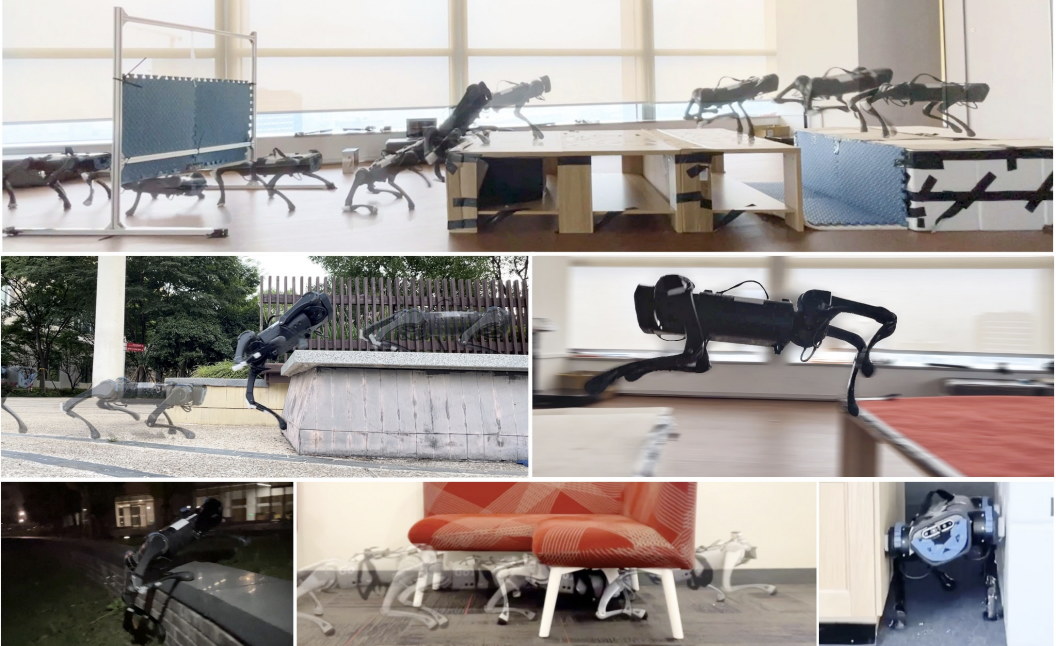Can Low-Cost Quadrupedal Robots Master Parkour? Unveiling a Revolutionary Learning System for Agile Robotic Movement

The quest to make robots perform complex physical tasks, such as navigating challenging environments, has been a long-standing challenge in robotics. One of the most demanding tasks in this domain is parkour, a sport that involves traversing obstacles with speed and agility. Parkour requires a combination of skills, including climbing, leaping, crawling, and tilting, which is particularly challenging for robots due to the need for precise coordination, perception, and decision-making. The primary problem this paper and article aim to address is how to efficiently teach robots these agile parkour skills, enabling them to navigate through diverse real-world scenarios.
Before delving into the proposed solution, it’s essential to understand the current state of the art in robotic locomotion. Traditional methods often involve manually designing control strategies, which can be highly labor-intensive and need more adaptability to different scenarios. Reinforcement learning (RL) has shown promise in teaching robots complex tasks. However, RL methods face challenges related to exploration and transferring learned skills from simulation to the real world.
Now, let’s explore the innovative approach introduced by a research team to tackle these challenges. The researchers have developed a two-stage RL method designed to effectively teach parkour skills to robots. The uniqueness of their approach lies in integrating “soft dynamics constraints” during the initial training phase, which is crucial for efficient skill acquisition.
The researchers’ approach comprises several key components contributing to its effectiveness.
1. Specialized Skill Policies: The method’s foundation involves constructing specialized skill policies essential for parkour. These policies are created using a combination of recurrent neural networks (GRU) and multilayer perceptrons (MLP) that output joint positions. They consider various sensory inputs, including depth images, proprioception (awareness of the body’s position), previous actions, and more. This combination of inputs allows robots to make informed decisions based on their environment.
2. Soft Dynamics Constraints: The approach’s innovative aspect is using “soft dynamics constraints” during the initial training phase. These constraints guide the learning process by providing robots with critical information about their environment. By introducing soft dynamics constraints, the researchers ensure that robots can explore and learn parkour skills efficiently. This results in faster learning and improved performance.
3. Simulated Environments: The researchers employ simulated environments created with IsaacGym to train the specialized skill policies. These environments consist of 40 tracks, each containing 20 obstacles of varying difficulties. The obstacles’ properties, such as height, width, and depth, increase linearly in complexity across the tracks. This setup allows robots to learn progressively challenging parkour skills.
4. Reward Structures: Reward structures are crucial in reinforcement learning. The researchers meticulously define reward terms for each specialized skill policy. These reward terms align with specific objectives, such as velocity, energy conservation, penetration depth, and penetration volume. The reward structures are carefully designed to incentivize and discourage undesirable behaviors.
5. Domain Adaptation: Transferring skills learned in simulation to the real world is a substantial challenge in robotics. The researchers employ domain adaptation techniques to bridge this gap. Robots can apply their parkour abilities in practical settings by adapting the skills acquired in simulated environments to real-world scenarios.
6. Vision as a Key Component: Vision plays a pivotal role in enabling robots to perform parkour with agility. Vision sensors, such as depth cameras, provide robots with critical information about their surroundings. This visual perception enables robots to sense obstacle properties, prepare for agile maneuvers, and make informed decisions while approaching obstacles.
7. Performance: The proposed method surpasses several baseline methods and ablations. Notably, the two-stage RL approach with soft dynamics constraints accelerates learning significantly. Robots trained using this method achieve higher success rates in tasks requiring exploration, including climbing, leaping, crawling, and tilting. Additionally, recurrent neural networks prove indispensable for skills that demand memory, such as climbing and jumping.
In conclusion, this research addresses the challenge of efficiently teaching robots agile parkour skills. The innovative two-stage RL approach with soft dynamics constraints has revolutionized how robots acquire these skills. It leverages vision, simulation, reward structures, and domain adaptation, opening up new possibilities for robots to navigate complex environments with precision and agility. Vision’s integration underscores its importance in robotic dexterity, allowing real-time perception and dynamic decision-making. In summary, this innovative approach marks a significant advancement in robotic locomotion, solving the problem of teaching parkour skills and expanding robots’ capabilities in complex tasks.
Check out the Paper, Code, and Project Page. All Credit For This Research Goes To the Researchers on This Project. Also, don’t forget to join our 30k+ ML SubReddit, 40k+ Facebook Community, Discord Channel, and Email Newsletter, where we share the latest AI research news, cool AI projects, and more.
If you like our work, you will love our newsletter..
![]()
Madhur Garg is a consulting intern at MarktechPost. He is currently pursuing his B.Tech in Civil and Environmental Engineering from the Indian Institute of Technology (IIT), Patna. He shares a strong passion for Machine Learning and enjoys exploring the latest advancements in technologies and their practical applications. With a keen interest in artificial intelligence and its diverse applications, Madhur is determined to contribute to the field of Data Science and leverage its potential impact in various industries.













